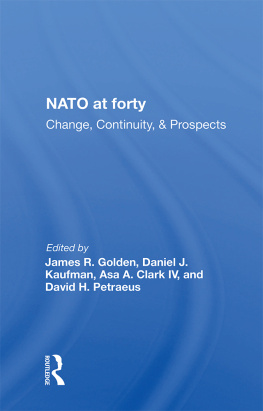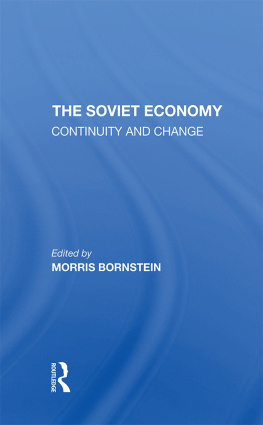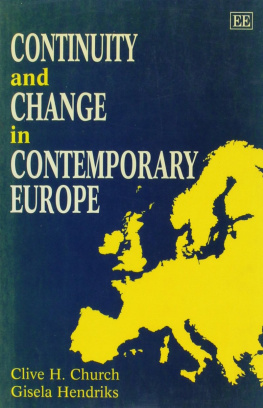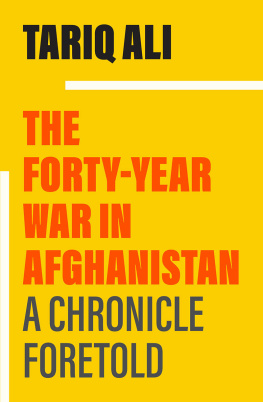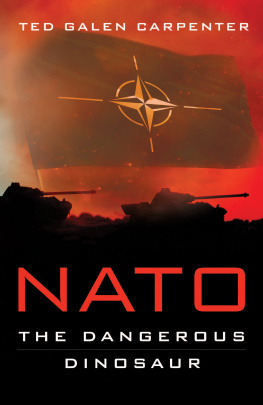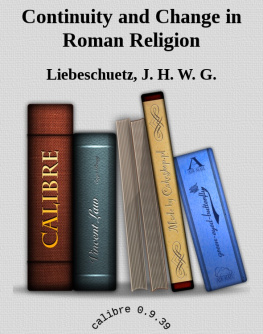First published 1989 by Westview Press, Inc.
Published 2018 by Routledge
52 Vanderbilt Avenue, New York, NY 10017
2 Park Square, Milton Park, Abingdon, Oxon OX14 4RN
Routledge is an imprint of the Taylor & Francis Group, an informa business
Copyright 1989 Taylor & Francis
All rights reserved. No part of this book may be reprinted or reproduced or utilised in any form or by any electronic, mechanical, or other means, now known or hereafter invented, including photocopying and recording, or in any information storage or retrieval system, without permission in writing from the publishers.
Notice:
Product or corporate names may be trademarks or registered trademarks, and are used only for identification and explanation without intent to infringe.
Library of Congress Cataloging-in-Publication Data
NATO at forty: change, continuity, and prospects / edited by James R.
Golden... [et al.].
p. cm.
ISBN 0-8133-0943-3
1. North Atlantic Treaty OrganizationHistory. I. Golden, James
Reed. II. Title: NATO at 40.
D845.2.N19 1989
335'.031'091821dc20 89-32848
CIP
ISBN 13: 978-0-367-00356-2 (hbk)
When in the second half of 1971 I took up my duties as Secretary General of the North Atlantic Treaty Organization (NATO), various reporters asked me what I was going to do about the decline of the Alliance. When I relinquished my position in the summer of 1984, they were still asking the same question. In fact, throughout the whole existence of NATO, prominent academics and members of the press have predicted the imminent collapse and dissolution of the Western Alliance. It is not surprising, therefore, that we now hear, with as much conviction as ever, the same voices of impending doom.
Throughout its four decades, however, the Alliance has defied those who have prophesied its impending demise. NATO has proved to be remarkably durable. Indeed, it has now outlasted all multilateral peacetime alliances in modern history. To be sure, few, if any, of NATO's forty years could be described as having been tranquil. The Alliance has always been confronted by challengesfrom within as well as from without. Alliance members withstood Soviet pressure against Berlin twice (1949 and 1962) and, more recently, refused to yield to Kremlin pressure and deployed the U.S. Pershing II and ground-launched cruise missiles. There has been no shortage of internal crises either: Suez, Cyprus, and the French withdrawal from the integrated military structure are but three of the more contentious ones. In addition, virtually every issue central to the trans-Atlantic partnership has been debated at one time or another. Alliance strategy, the proper course of East-West relations, the amount that member nations should contribute to the collective defense, Alliance policy on a variety of out-of-area issues, the magnitude of the Soviet military threateach of these has been the subject of intense controversy. Through it all, however, NATO has endured. The perceived benefits of NATO's collective approach to security have been accepted as worth the burdens and costs of Alliance membership.
This durability does not mean that the Alliance should be taken for granted or that members of the Atlantic community should be oblivious to the dangers of centrifugal forces within the Alliance. The chapters that follow contain considerable evidence that differences between NATO members do existand they will have to be addressed in the years ahead. Nonetheless, despite occasional quarrels and discord among its members, NATO consistently has shown more resilience than its critics have given it credit for. Many factors have helped hold the Alliance together and will help it to endure in the future, and these, too, are discussed in the pages that follow.
The Origins of the Alliance
In the foreword to a book about NATO at forty, it is appropriate for those of us who were present at the beginning to recall the origins of this unique organization. In fact, it is important that the West not forget the situation in Europe during the late 1940s and the factors that prompted the democracies of Europe and North America to make their security a common endeavor. The reins of leadership are passing from the last of the generation that lived through that period. We should not allow our memories of this episode to fade, however, for from them we can draw useful perspective and understanding that can guide us as we enter the last decade of the twentieth century and beyond.
The immediate impetus for the formation of NATO was the coup in Czechoslovakia and the establishment, in February 1948, of a communist regime in Prague that was completely dominated by Moscow. The events there were the culmination of a series of Soviet actions that had already established communist governments in the other Eastern European countries that constituted the area behind what Winston Churchill termed the "Iron Curtain." By the end of 1947, Yugoslavia, Albania, Bulgaria, Poland, Hungary, and Rumania had become communist states, and the Soviet-occupied portion of Germany was clearly dominated by the USSR. Moreover, Soviet activism extended beyond Eastern Europe. The USSR also exerted heavy political pressure in Northern Iran, Turkey, Greece, and various places in Asia.
Concerned by these developments, five Western European nationsGreat Britain, France, the Netherlands, Belgium, and Luxembourginitiated talks on ways to commonly resist aggression or coercion against them by the Soviet Union. These countries were militarily weak, however, having been demobilized completely after the end of World War II. They also were still suffering from the appalling destruction of the war; the pace of Western European economic recovery was agonizingly slow. Their military weakness and economic frailty gave rise to concerns about their individual abilities to withstand Soviet attempts to intimidate them; they also were uncertain about their capability to defend themselves if that became necessary. More important, they were willing to act in concert to preserve their security. Thus in March 1948, after two weeks of discussions, they signed the Treaty of Brussels, pledging collaboration in a number of areas, including collective self-defense.
The group's determination to resist intimidation by the massive Soviet military machine in Eastern Europe greatly impressed the United States. West European collaboration was precisely what American leaders had made a precondition for the extension of economic assistance under the Marshall Plan, and Washington lost no time in informing the signatories of the Brussels Treaty that the United States would study the possibility of joining them in a defensive alliance. In June 1948, following consultations with the State Department, the U.S. Senate indicated the importance it attached to the Brussels Treaty. In adopting the Vandenburg Resolution, the Senate recommended "the association of the United States, by constitutional process, with such regional and other collective arrangements as are based on continuous and effective self-help and mutual aid." This action paved the way for American participation in the trans-Atlantic security partnership. Thus by June 1948, when the Soviets began their blockade of Berlin, the foundation for NATO had already been laid.


